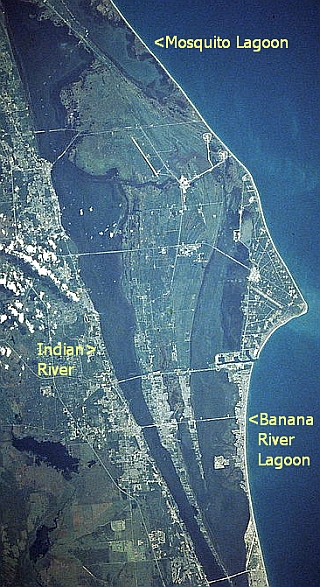Category:National Estuary

The Indian River Lagoon National Estuary is a 156-mile long estuary spanning 40% of Florida's East Coast. The estuary's 3 main water bodies are the Mosquito, Banana River and Indian River lagoons.[1]
Despite it's name, the Indian River is actually a bar-built lagoon with no directional current flow. It's brackish water body is a confluence of 4 saltwater Atlantic Ocean inlets, 5 freshwater rivers and numerous feeder creeks. Within it's boundaries are an Air Force Base, a National Space Center, a National Seashore, two National Wildlife Refuges, and several wildlife sanctuaries. It's vast waters provide an outdoor recreational playground for boaters, fishers, birders, campers, hikers, bikers and day trippers alike.
It's temperate location and varied habitats make the Indian River Estuary one of the most bio-diverse habitats in North America. The estuary's mangrove shorelines, spoil islands, oyster bars, saltwater marshes, and seagrass flats provide habitat for terrestrial and aquatic species found in both fresh, and salt water ecosystems. The estuary is home to over 4000 plant and animal species, some threatened or endangered.
Economy
A healthy estuary is a vital economic factor in the community. The estuary provides direct income for resident's who work both on and off the water. Commercial fishing, ecotourism, outdoor equipment retail, watercraft sales/service, and marina industries all directly depend on the estuary for income. Indirectly, the economic success of the above industries also increases earnings for local tourism, hospitality, transportation and real estate industries. A 2016 Economic Valuation Study, conducted by Hazen and Sawyer water consultants for the St. John Water Management District (SJWMD), estimated the Indian River Lagoon Estuary's economic value at $7,640,311,564 per year.[2]
Human Impact
The Indian River Lagoon National Estuary spreads across Volusia, Brevard, Indian River, St. Lucie, Martin, and Palm Beach counties with a rapidly growing population of 1.5 million residents. Waterfront residents enjoy a panoramic view, a parade of watercraft, unique wildlife sightings, and private boat docks with instant water access. Condominium dwellers enjoy well manicured landscaping, large paved parking lots and a convenient shopping plaza nearby. Human impact from inadequate sewer utilities, seeping septic tank drain fields, stormwater run-off polluted with lawn fertilizer, and excessive wetland development has drastically affected the estuary's health.
The result of this adverse human impact could be seen in a 2016 green algal bloom. Fueled by an excess of phosphorous and nitrogen, the blooming algae created a lack of oxygen in the water, which caused widespread fish kills across Florida's East Coast. The algal bloom rendered parts of the estuary innavigable; turned lush waterfront real estate into undesirable eyesores; caused respiratory health problems for residents; killed many aquatic plants and animals; and completely devastated the local ecotourism industry.[3]
A National Treasure

In 1990, the Indian River Lagoon was chosen as an Estuary of National Significance and assigned to the National Estuary Program (NEP) within the U.S. Environmental Protection Agency (EPA).[4] The new National Estuary's first program steward was Florida's St. Johns Water Management District (SJWMD). In 2015, the State of Florida created a special district named the IRL Council[5] to oversee the Indian River Lagoon National Estuary Program.
Pages in category "National Estuary"
The following 5 pages are in this category, out of 5 total.
